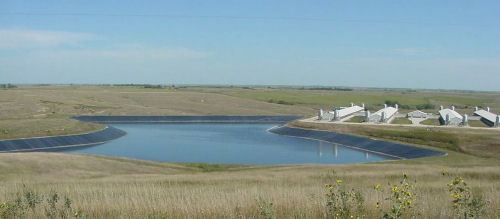Printer friendly version of this summary.
Does It Make a Difference If a New Pig Barn is Built In an Area With Existing Barns?
A model, called the Community Assessment Model for Odor Dispersion (CAM), was developed to predict receptor odor exposure from multiple swine production sources. The intended use of CAM was to provide a tool for evaluating the odor exposure to receptors in a community when siting new swine production systems and how a change in odor control technology alters the odor exposure to receptors.
CAM can handle up to 20 swine production sources with up to 100 receptors in a community of any size. CAM predicts the number of hours of exposure to weak (2:1) and greater or identifiable (7:1) and greater odors and these are used to assess siting options.
Activities
CAM has been used in the state of Iowa for over 150 specific cases since June, 2005. The implementation of CAM has been a voluntary process, initiated by the farmer and implemented through a joint effort between the Coalition to Support Iowa’s Farmers (CSIF), the Iowa Pork Industry Center (IPIC), and faculty with Iowa State University’s College of Agriculture and Life Sciences. The use of CAM requires on on-site visit to assess and map community receptors and existing animal-related odor sources.
The mapped data is then brought to the Department of Agricultural and Biosystems Engineering where one of two faculty members implement CAM. A one-page report is generated and this report is given to the farmer, through a follow-up on-site visit with an IPIC staff member. At the conclusion of a CAM modeling run, a staff member from IPIC conducts a follow-up site visit with the farmer to explain results of CAM predictions. The estimated total expense (currently free to the farmer) to implement CAM is $1,000 per siting case.
What We Have Learned
Modeling odor dispersion by itself is a relatively straight-forward procedure. The difficulty arises when a modeling procedure is to be used by farmers and community planners to guide facility siting choices. Any modeling procedure developed must be based on an accepted modeling platform, must incorporate site parameters that can be applied equitably to a wide range of field conditions, must have the ability to easily handle multiple sources and multiple receptors, and must predict odor concentration that is conservative for the receptor without being overly restrictive for the farmer. Any odor dispersion model that incorporates these considerations and shows good agreement with field collected odor data could be considered for siting purposes.
Why is This Important?
Having the ability to fairly and accurately determine the adequacy of a proposed siting choice is imperative for the future expansion of animal agriculture.
For More Information
Authors: Steven Hoff, hoffer@iastate.edu or (515) 294-6180, Jay Harmon and Colin Johnson, Iowa State University
- Hoff, S. J. and D. S. Bundy. 2003. Modeling odor dispersion from multiple sources to multiple receptors. In: Proceedings of the International Symposium on Gaseous and Odour Emissions from Animal Production Facilities. Norsens, Denmark. June 1-4, 2003. pp 331-339.
- Hoff, S. J., D. S. Bundy, and J.D. Harmon. 2008. Modeling receptor odor exposure from swine production sources. Applied Engineering in Agriculture (in-review).
- Photo CC 2.5 Rick Koelsch
This report was prepared for the 2008 annual meeting of the regional research committee, S-1032 “Animal Manure and Waste Utilization, Treatment and Nuisance Avoidance for a Sustainable Agriculture”. This report is not peer-reviewed and the author has sole responsibility for the content.




